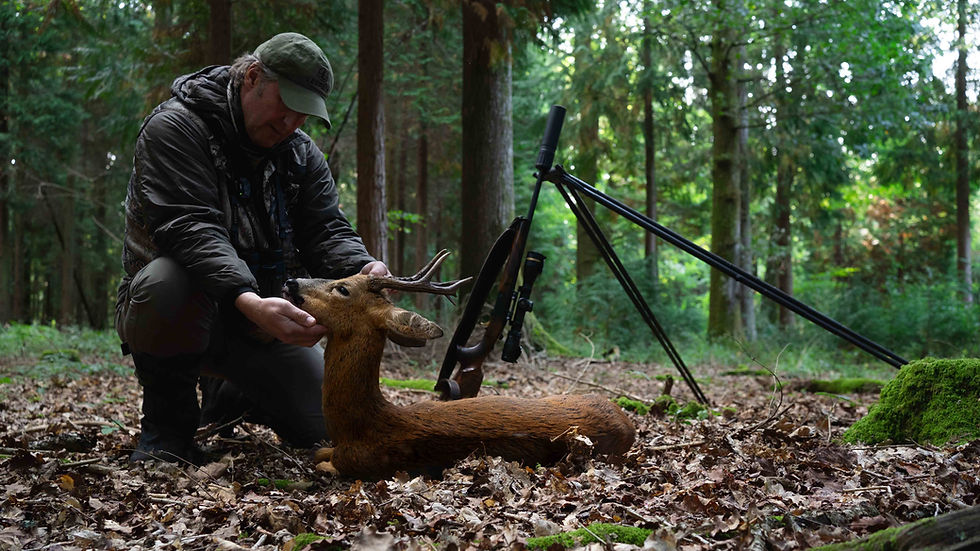10 Tips For Calling in the Roe Rut
- Owen Beardsmore

- Jul 4
- 4 min read
Updated: Jul 7
After weeks of dry heat across May and June, the fields are already turning golden — and with them comes that familiar stir of anticipation. The Roe Rut is nearly upon us.
Here in England, we look toward the last ten days of July/first two weeks of August with cautious optimism. When the stars align — warm air, steady pressure, and willing deer — there’s no thrill quite like calling in a good mature Roebuck, you've been seeing all Spring. And while it’s never an exact science, here are ten Cervus-UK tips we’ve learned through years of trial, error, and the occasional bit of blind luck.

1. Don’t Start Too Early — in the Day or the Month
We don’t begin calling before 7AM, and we rarely start the rut campaign in earnest until around the 23rd to 25th of July. We like to witness the activity first, either on live trail camera or out in the woods. Calling too early — in either sense — risks educating deer and burning out a good area before it really kicks off.
2. Think Like a Buck
Timing matters. We often find our best success mid-morning, after the chill has lifted — around 8.30–11AM — especially in areas with decent woodland cover. Let the day warm up a bit before you start serenading.
3. Scout First, Call Later
Your success rate will skyrocket if you’ve done your recon ahead of time. Know where your target bucks are bedding, feeding, and moving. Deploy trail cameras, check salt licks, walk rides — it’s prep that pays.

4. Don’t Blow Your Best Buck on Day One
Resist the urge to call your mature target buck straight away. Early in the rut, you’ll often call in the younger, nosier bucks first. Use that time to read the mood of the season. Call other spots first. Save the big boy till the rut is properly boiling.
5. Pick the Right Spot, Not Just the Right Sound
Cooler, shaded woodland areas have often produced more reliable action for us, though in some years, the open fields have delivered too. Pay attention to where you’ve seen movement and you know and have previously observed a buck territory or where your doe has been situated throughout the spring.

6. Have a Plan — Decide What You Want to Call
Are you out to cull a yearling or take a mature beast? Are you managing numbers or looking for a trophy? Your intention changes the game — and the approach. Don’t just call for the sake of it, as you only educate the area.
7. Don’t Take It Too Seriously
Some days you call for 45 minutes and nothing happens. Others, a buck sprints in from nowhere in seconds. Enjoy the moment. Learn from the blank sessions. It’s not a science. It’s a dance and an unreliable one! But when it happens it's a force of nature.

8. Use the Right Call for the Moment
The Buttolo is always reliable, especially over distance. Last year, the raspy, excited tones of the Lockschmiede Rehblatter stole the show in combination with the Fiep-piu call and it's ability to change tone via a turn-screw. Every year’s a little different — you have to find the rythym of the rut and call that works. If one doesn't get a result, switch to another out of your call bag.
9. Warmth and Stillness Win
Rutting activity isn’t dictated by calendar dates alone. Good, consistent weather is key and humidity a sure thing to get them going. Bucks will run in the heat — they just won’t move if it's cold or windy. Look for still, warm mornings and early evenings.
10. Be Ready for Change
Last year, we saw more mid-afternoon Roe movement than usual — between 2–4PM. Many does had single fawns last year, hinting at the toll spring weather had taken. Whereas this year we have twins everywhere. Every season has its quirks. Adapt with it.

Final Thoughts
This isn’t farming. There’s no yield to guarantee. The Roe Rut is a blend of instinct, timing, and patience — coupled with huge amounts of frustration — and later this month, with the land sunbaked and buzzing with life, we’re hopeful.
So get out there. Take your time. Have a plan. But don’t forget to have fun and definetely don't rely on it! Because when and if that buck comes crashing in, eyes wide and heart pounding — there’s nothing quite like it. Got this far and want to learn more? We're developing a first of it's kind - an exclusive Roebuck Calling Workshop. Click the button below to access the pre-register waitlist now.







Very informative as usual! Great work.